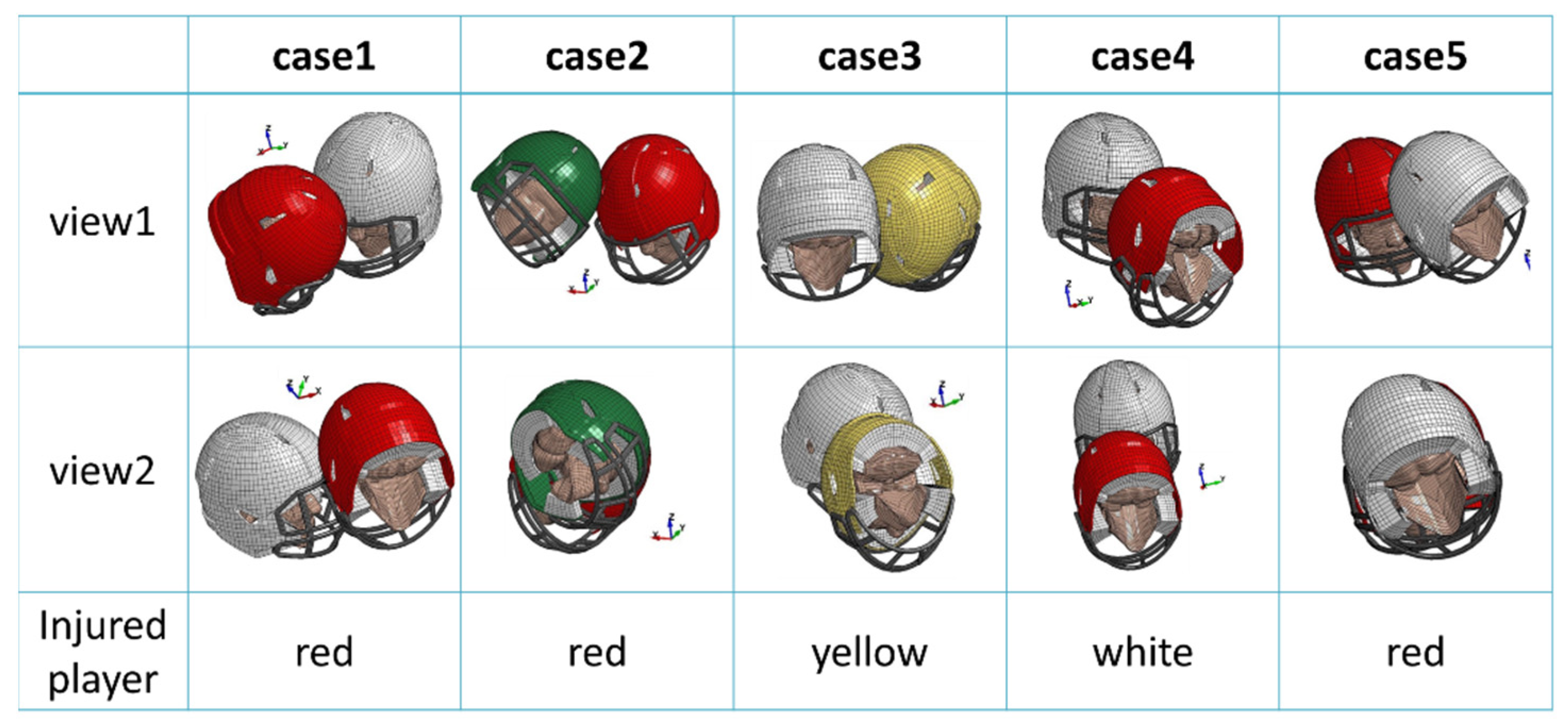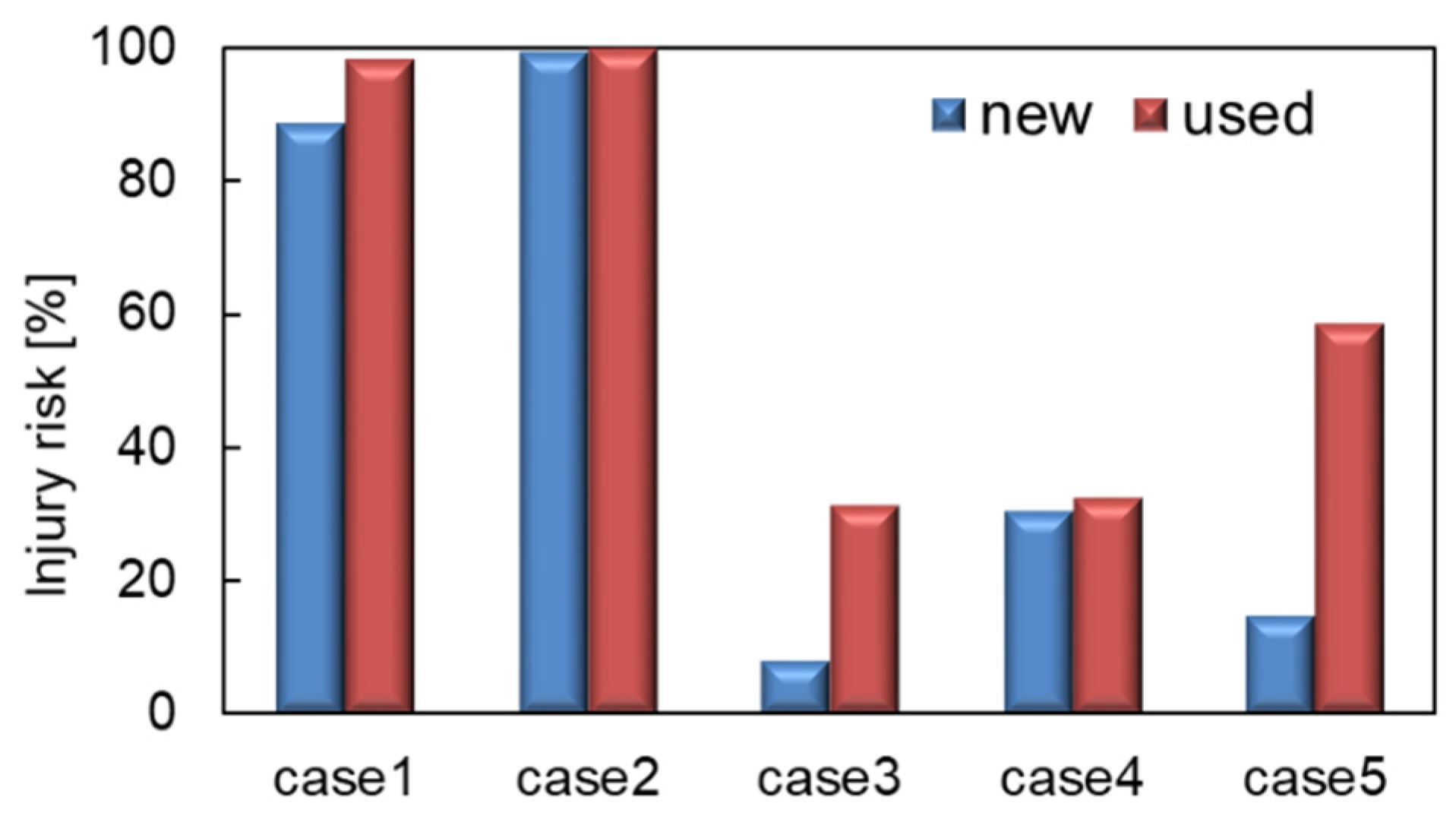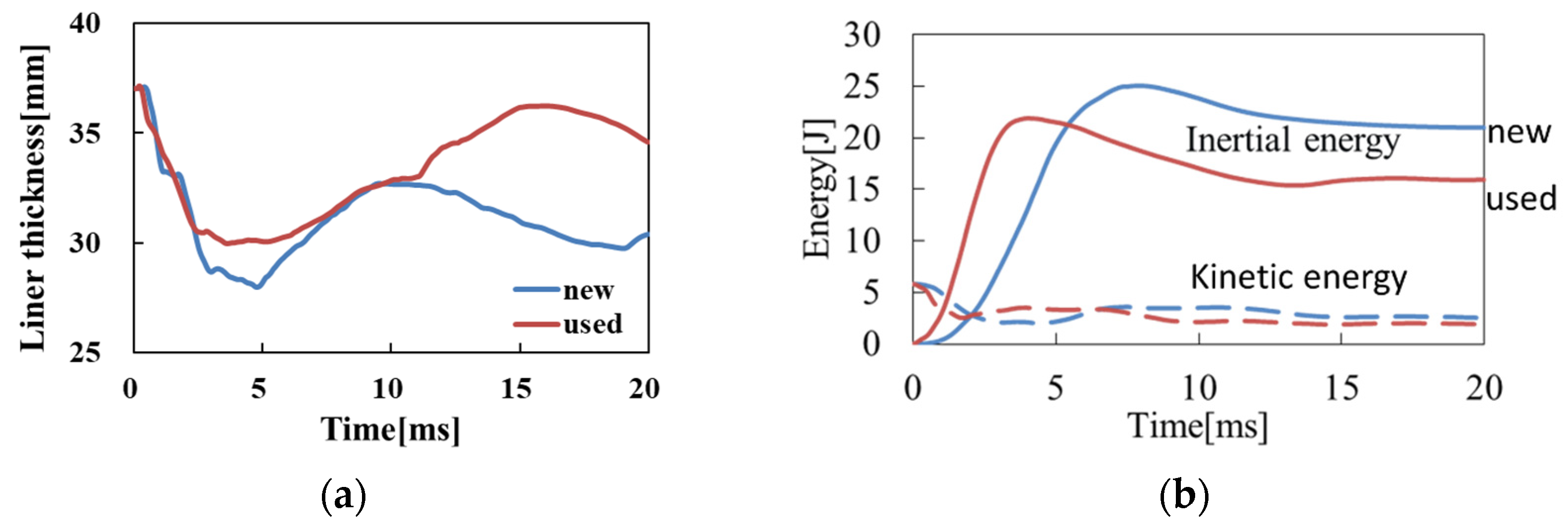Influence of Long-Term Use of American Football Helmets on Concussion Risk
Abstract
:1. Introduction
2. Materials and Methods
2.1. Injury Estimation System
2.2. Body Mathematical and FE Models
3. Results
3.1. Motion Analysis of Head-to-Head Impact Accident Cases
3.2. Mechanical Parameter Obtained inside the Skull and Injury Estimation
4. Discussion
5. Conclusions
Author Contributions
Funding
Institutional Review Board Statement
Informed Consent Statement
Data Availability Statement
Acknowledgments
Conflicts of Interest
References
- Fukuda, T.; Koike, S.; Miyakawa, S.; Fujiya, H.; Takemura, M.; Yamamoto, Y. Effect of collision on the helmet of American Football. In Proceedings of the Symposium: Sports Publishing and Human Dynamics, Tokyo, Japan, 1–3 November 2013. [Google Scholar]
- Levy, M.L.; Ozgur, B.M.; Berry, C.; Aryan, H.E.; Apuzzo, M.L. Birth and evolution of the football helmet. Neurosurgery 2004, 55, 656–661. [Google Scholar] [CrossRef] [PubMed]
- Cournoyer, J.; Post, A.; Rousseau, P.; Hoshizaki, B. The ability of American football helmets to manage linear acceleration with repeated high-energy impacts. J. Athl. Train 2016, 51, 258–263. [Google Scholar] [CrossRef] [PubMed]
- Newman, J.A.; Barr, C.; Beusenberg, M.; Fournier, E.; Shewchenko, N.; Welbourne, E.; Withnall, C. A new biomechanical assessment of mild traumatic brain injury Part 2: Results and conclusions. In Proceedings of the IRCOBI Conference, Montpellier, France, 20–22 September 2000. [Google Scholar]
- Kleiven, S. Predictors for traumatic brain injuries evaluated through accident reconstructions. In Stapp Car Crash Journal Proceedings of the 51st Stapp Car Crash Conference, CA, USA, 29–31 October 2007; SAE Technical Paper: Troy, MI, USA, 2007. [Google Scholar] [CrossRef]
- Darling, T.; Muthuswamy, J.; Rajan, S.D. Finite element modeling of human brain response to football helmet impacts. Comput. Methods Biomech. Biomed. Engin. 2016, 19, 1432–1442. [Google Scholar] [CrossRef] [PubMed]
- Zhang, L.Y.; Yang, K.H.; King, A.I.; Viano, D.C. A new biomechanical predictor for mild traumatic brain injury—A preliminary finding. In Proceedings of the Summer Bioengineering Conference, Key Biscayne, FL, USA, 25–29 June 2003. [Google Scholar]
- Aomura, S.; Zhang, Y.L.; Nakadate, H.; Koyama, T.; Nishimura, A. Brain injury estimate of collegiate football player based on game video of concussion suspected accident. J. Biomech. Sci. Eng. 2016, 11, 16–00393. [Google Scholar] [CrossRef]
- Zhang, Y.L.; Han, L.; Hosono, D.; Matsuda, T.; Niita, O.; Nakadate, H.; Kamitani, T.; Aomura, S. Traumatic brain injury risk evaluation during Judo based on reconstruction analysis of accident cases. J. JPN Soc. Exp. Mech. 2017, 17, 153–161. (In Japanese) [Google Scholar]
- Manuals of Human Models; MADYMO, Ver.7.5; TASS International corporation: Helmond, The Netherlands, 2015; pp. 59–61.
- Zhang, Y.L.; Miyoshi, K.; Han, L.; Nakadate, H.; Yoneyama, S.; Koyama, T.; Aomura, S. Injury risk evaluation of brain concussion in American football based on reproduction analysis of accident cases. J. Adv. Exp. Mech. 2018, 3, 197–202. [Google Scholar]
- Viano, D.C.; Casson, I.R.; Pellman, E.J. Concussion in professional football: Biomechanics of the struck player—Part 14. J. Neurosurg. 2007, 61, 313–327. [Google Scholar] [CrossRef] [PubMed]







| Scalp | Facial Bone | Outer/Inner Table | Diploe | CSF/ Ventricle | Cerebrum | Brain Stem | Corpus Callosum | Falx/ Tentorium | Cerebellum | |
|---|---|---|---|---|---|---|---|---|---|---|
| Density ρ [kg/m3] | 1000 | 1213 | 1456 | 850 | 1040 | 1040 | 1040 | 1040 | 1130 | 1040 |
| Young’s Modulus E [MPa] | 16.7 | 5000 | 5000 | 2320 | - | - | - | - | 31.5 | - |
| Bulk Modulus K [MPa] | - | - | - | - | 2190 | 2190 | 2190 | 2190 | - | 2190 |
| Short Time Shear Modulus G0 [MPa] | - | - | - | - | - | 0.0125 | 0.0225 | 0.041 | - | 0.01 |
| Long Time Modulus G∞ [MPa] | - | - | - | - | 0.0005 | 0.0025 | 0.0045 | 0.0078 | - | 0.002 |
| Poisson’s Ratio ν [−] | 0.42 | 0.23 | 0.25 | - | - | - | - | - | - | - |
| Decay coefficient [s−1] | 500,000 | 80 | 80 | 400 | 0.45 | 80 |
| Case No. | Injured Payer | Velocities | |||||||||||
|---|---|---|---|---|---|---|---|---|---|---|---|---|---|
| Striking Player | Struck Player | ||||||||||||
| Translational [m/s] | Rotational [rad/s] | Translational [m/s] | Rotational [rad/s] | ||||||||||
| x | y | z | x | y | z | x | y | z | x | y | z | ||
| 1 | Struck | 3.6 | −1.3 | −2.4 | −0.68 | 1.6 | −2.1 | −4.2 | 1.5 | 0.08 | 0.35 | −0.27 | −2.0 |
| 2 | Struck | −5.7 | 0.44 | −0.50 | −0.021 | −0.01 | −0.77 | 3.1 | 0.67 | −1.4 | −2.9 | 1.3 | 0.90 |
| 3 | Striking | −1.1 | −4.1 | −0.80 | 0.27 | −0.13 | −3.9 | 2.0 | 1.2 | 0.24 | −0.29 | −0.05 | −2.1 |
| 4 | Struck | 3.9 | 0.47 | 1.8 | −1.0 | 2.4 | −0.42 | 1.7 | 0.92 | −1.9 | −0.57 | 5.5 | 1.6 |
| 5 | Striking | −2.5 | −1.6 | −0.12 | −1.4 | 1.0 | −8.3 | 4.2 | 0.02 | −0.13 | −0.09 | −0.20 | 0.09 |
Disclaimer/Publisher’s Note: The statements, opinions and data contained in all publications are solely those of the individual author(s) and contributor(s) and not of MDPI and/or the editor(s). MDPI and/or the editor(s) disclaim responsibility for any injury to people or property resulting from any ideas, methods, instructions or products referred to in the content. |
© 2024 by the authors. Licensee MDPI, Basel, Switzerland. This article is an open access article distributed under the terms and conditions of the Creative Commons Attribution (CC BY) license (https://creativecommons.org/licenses/by/4.0/).
Share and Cite
Zhang, Y.; Mitsui, M.; Yoneyama, S.; Aomura, S. Influence of Long-Term Use of American Football Helmets on Concussion Risk. Brain Sci. 2024, 14, 537. https://doi.org/10.3390/brainsci14060537
Zhang Y, Mitsui M, Yoneyama S, Aomura S. Influence of Long-Term Use of American Football Helmets on Concussion Risk. Brain Sciences. 2024; 14(6):537. https://doi.org/10.3390/brainsci14060537
Chicago/Turabian StyleZhang, Yuelin, Mayuko Mitsui, Satoru Yoneyama, and Shigeru Aomura. 2024. "Influence of Long-Term Use of American Football Helmets on Concussion Risk" Brain Sciences 14, no. 6: 537. https://doi.org/10.3390/brainsci14060537




